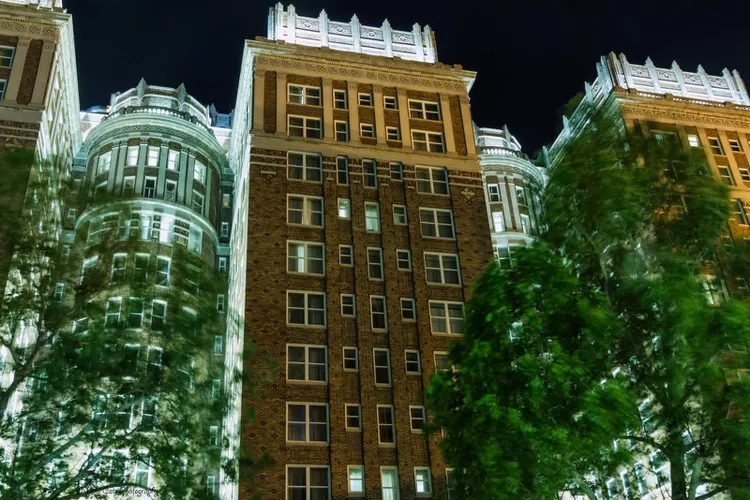The Enigmatic Skirvin Hotel in Oklahoma City
Not only is it one of the absolute best hotels in Oklahoma City, but the downtown Skirvin Hotel is also one of the metro’s most historic establishments. However, is it haunted? That’s the question so many want to know. Consequently, let’s review a brief history of the Skirvin Hotel, including ghost stories and reported hauntings.
1. History
William Balser “Bill” Skirvin, a Land Run participant and wealthy Texas oilman, moved his family to Oklahoma City in 1906. He invested in oil and land, thereby increasing his wealth considerably. In 1910, he decided to build a hotel on one of his properties at 1st and Broadway after an investor from New York City offered to buy the lot to construct what would be known as the “biggest hotel” in the state. At the time, Oklahoma City had only one luxury hotel, and Skirvin perceived it as an excellent investment opportunity.
Skirvin approached Solomon A. Layton, a renowned local architect who designed the Oklahoma State Capitol building, and plans were finalized for a 6-story, U-shaped hotel. However, in late 1910, just as construction of the fifth story neared completion, Layton convinced Skirvin that OKC’s growth justified a ten-story hotel instead of six.
On September 26, 1911, Skirvin opened the newly completed luxury hotel to the public. The lobby was stylishly decorated in English Gothic design, and the wings of the hotel included a drugstore, retail shops, and a café. The hotel featured 225 rooms and suites, each equipped with a private bath, telephone, hardwood furniture, and luxurious velvet carpet.
According to numerous accounts, the hotel quickly became a gathering place for well-known businessmen and politicians over the subsequent decade. As a result, Skirvin began to expand the hotel, starting with the construction of a new 12-story wing, eventually raising all wings to 14 stories by 1930. This expansion increased the total room count to 525 and added a roof garden, cabaret club, and doubled the lobby size.
Despite the economic difficulties faced nationally during the Great Depression, the oil boom in Oklahoma City kept the Skirvin Hotel robust. Unfortunately, William Skirvin’s health declined, and he operated the hotel until his death in 1944. Following this, his three children sold the property to Dan W. James in 1945.
James promptly initiated extensive modern renovations, adding amenities such as room service, a beauty shop, a barber shop, a swimming pool, and a house physician. The Skirvin Hotel gained further prominence, hosting Presidents Harry Truman and Dwight D. Eisenhower. However, by 1959, suburban expansion negatively impacted downtown OKC, prompting James to sell the Skirvin Hotel to Chicago investors in 1963. It was later sold again in 1968 to H.T. Griffin.
Griffin invested millions into remodeling the Skirvin Hotel, but business continued to struggle, leading him to file for bankruptcy in 1971. After changing hands multiple times, the hotel underwent additional renovations in the 1970s and again in the early 1980s, ultimately closing in 1988.
In 2002, the city of Oklahoma City acquired the property and devised a financing plan to “renovate, restore, and reopen.” As a result, the Skirvin Hotel finally reopened its doors on February 26, 2007.
2. The Skirvin Haunting
The primary ghost story associated with the Skirvin Hotel revolves around a young maid nicknamed “Effie.” According to legends, William Skirvin had an affair with Effie, resulting in her pregnancy. To avoid potential scandal, he allegedly locked her in a room on the 10th floor, which was originally the top floor. Isolated and despondent, she reportedly leaped from the window, holding her infant child in her arms.
Throughout the hotel’s existence, guests have frequently complained about sleepless nights, often due to the sounds of a child crying. Moreover, some have reported sightings of a nude Effie appearing to male hotel guests while showering, with her voice sometimes heard propositioning them. Staff members have experienced a range of strange occurrences, from unusual noises to objects moving inexplicably.
While the Effie legend is widespread, historical evidence supporting it is lacking. Though William Skirvin is said to be a notorious womanizer, and the 10th floor may have been a popular location for gamblers and prostitutes in the 1930s, writers Steve Lackmeyer and Jack Money conducted extensive research for their publication Skirvin but discovered no substantiation for the Effie narrative. Notably, the only documented suicide at the Skirvin was that of a salesman who jumped from his window.





